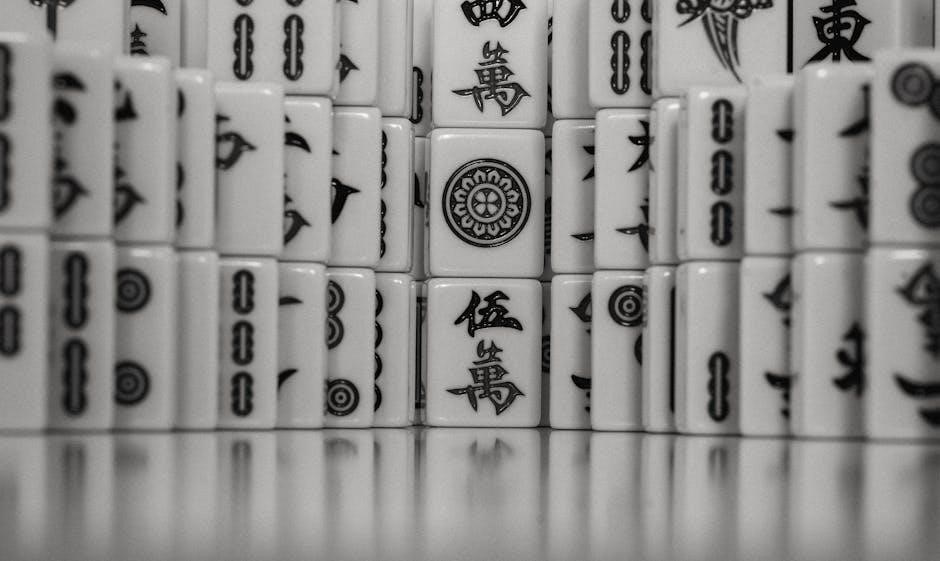Chinese Mahjong is a complex, strategic tile-based game with deep historical roots. While it offers simplified rules for beginners, its variations and scoring systems can be intricate. The game combines luck, skill, and strategy, making it appealing to diverse players worldwide.
1.1. Brief History and Evolution of Mahjong
Chinese Mahjong, with roots tracing back to 19th-century China, has evolved significantly over time. Its origins are debated, but it is believed to have derived from earlier card games. The game spread rapidly, adapting to regional preferences, leading to diverse rulesets. The modern version emerged in the 20th century, with standardized rules forming the basis of today’s variations. Over time, Mahjong has incorporated elements like scoring systems and special patterns, reflecting cultural influences. Its evolution continues, with new variants like Zung Jung emerging to simplify the game for beginners while maintaining its strategic depth. This rich history underscores Mahjong’s adaptability and enduring appeal as a global phenomenon.
1.2. Importance of Understanding the Rules
Understanding the rules of Chinese Mahjong is essential for effective gameplay and fair competition. Without a solid grasp of the regulations, players may struggle to navigate the game’s complexities, leading to confusion and potential disputes. The rules provide a foundation for strategic planning and ensure that all players are on the same page. They dictate tile arrangements, meld formations, and scoring systems, which are critical for maximizing your chances of winning. Moreover, knowing the rules enhances your ability to adapt to different playing styles and regional variations. Mastery of the rules not only improves your performance but also elevates your enjoyment of the game, making it more engaging and rewarding for everyone involved.
Basic Rules of Chinese Mahjong
Chinese Mahjong involves 144 tiles, with four players each starting with 13 tiles. Turns consist of drawing and discarding tiles to form valid melds. The goal is to be the first to complete a legal hand and declare “Mahjong,” earning points based on the tiles left in opponents’ hands.
2.1. Number of Players and Equipment
Chinese Mahjong is traditionally played with four players, though variations exist for fewer players. The game requires a standard set of 144 tiles, including suits like Bamboos, Circles, and Characters, as well as Dragons, Winds, and Flowers. Additional tiles, such as Seasons and Flowers, may be included depending on the region. Players use a mat or table for gameplay, and tile racks are optional but common. Each player starts with a hand of 13 tiles, with the dealer receiving an extra tile. The equipment setup ensures fairness and organization, making the game accessible and enjoyable for participants of all skill levels.
2.2. The Setup: Preparing the Tiles
Preparing the tiles is a crucial step in Chinese Mahjong. The process begins with shuffling the tiles face down on the table. Players typically arrange the tiles into two rows of 17 tiles each, forming a wall. The dealer then takes the first tile from the wall, followed by the next player, and so on, until all players have 13 tiles. This setup ensures the tiles are randomly distributed and ready for gameplay. The remaining tiles are left in the wall, which players will draw from during the game. Proper preparation ensures a fair and organized start to the game.
2.3. Dealing the Tiles
Dealing the tiles in Chinese Mahjong is a structured process that ensures fairness. After the tiles are shuffled and arranged into two walls, the dealer takes the first tile, followed by the next player in a clockwise direction. Each player receives 13 tiles, with the dealer retaining the 14th tile after distribution. This ensures the dealer has the first opportunity to play. The remaining tiles are arranged into a wall for drawing during gameplay. The dealing process is critical as it sets the foundation for the game, ensuring each player starts with an equal chance. Proper tile distribution is essential for maintaining the integrity of the game.

2.4. The Initial Setup and First Move
After dealing the tiles, the initial setup involves arranging the remaining tiles into a wall, typically two rows of 17 tiles each. Players must ensure the wall is properly aligned and accessible. The first move begins with the dealer discarding a tile, setting the foundation for gameplay. The next player to the right then picks up a tile from the wall and discards one from their hand. This cycle continues, allowing players to strategize and form melds. The initial setup and first move are crucial as they establish the game’s tempo and opportunities for strategic plays. Proper alignment and adherence to turn order are essential for a fair and enjoyable game.
Gameplay Mechanics
Chinese Mahjong involves dynamic tile-based interactions, combining drawing, discarding, and forming melds. Players must pay attention to opponents’ moves, strategize, and aim to complete their hand first.
3.1. Drawing Tiles and Discarding
In Chinese Mahjong, gameplay begins with each player drawing tiles from the wall to complete their hand. After the initial deal, the player to the right of the dealer draws the first tile. Players then take turns drawing a tile from the wall or picking up a discarded tile that matches their needs. Discarding is a critical strategy, as it allows players to rid themselves of unwanted tiles while potentially disrupting opponents’ plans. A discarded tile is placed face-up in the center, and players must declare “mahjong” immediately if they can win with it. Proper timing and awareness are essential to maximize opportunities while minimizing risks.
3.2. Forming Melds: Chows, Pungs, and Kongs
In Chinese Mahjong, melds are essential for building a winning hand. A Chow is a sequence of three tiles from the same suit, such as 1-2-3 in bamboo. A Pung consists of three identical tiles, like three red dragons. A Kong is an extended Pung, made of four tiles of the same kind. Melds must be formed from tiles in a player’s hand or by picking up a discarded tile. Players can declare a meld by calling “Chow,” “Pung,” or “Kong” when they form one. Forming melds strategically helps players progress toward completing their hand and declaring “Mahjong;” Properly identifying and forming melds is a foundational skill in mastering the game.
3.3. Going Mahjong: Completing the Hand
Going Mahjong signifies successfully completing a hand according to the rules, leading to a win. A standard Mahjong hand requires 14 tiles, which must be arranged into four sets of three tiles each and a pair. These sets can be sequences (Chows), triplets (Pungs), or quadruplets (Kongs). Players must ensure all combinations are valid and cover all tiles. To declare Mahjong, a player must have exactly the right number of tiles with correctly formed combinations. The hand must be declared when the player picks up the final tile needed to complete their sets. Special winning hands, like “Heavenly” or “Earthly,” offer higher points but are beyond basic rules. The declaration process is crucial, ensuring adherence to the rules for a valid win.
Scoring in Chinese Mahjong
Scoring is based on the value of tiles and combinations, with points awarded for winning hands and special patterns. Each player’s score is calculated individually.
4.1. Basic Scoring Rules
In Chinese Mahjong, scoring is based on the value of tiles and combinations. Each tile type (e.g., circles, bamboos, characters) has a specific point value, with dragons, winds, and flowers worth more. Points are awarded to the winner from all other players, while losing players lose points proportional to their tile values. The base score is typically set at the start of the game, with the winner collecting this amount from each player. Bonus points are awarded for special patterns like “All One Suit” or “First to Declare Mahjong.” The minimum score to win is usually 8 points, and the maximum per hand is capped to prevent excessive scoring. Proper understanding of these rules ensures fair play and accurate settlements.
4.2. Scoring Patterns and Combinations
In Chinese Mahjong, scoring patterns and combinations significantly influence the total points. Common patterns include “All One Suit” (using tiles from a single suit), “First to Declare” (winning the hand first), and “Last Tile Win” (winning with the final tile). Combinations like “Triplets of Dragons” or “Quadruple of Flowers” award bonus points. Each pattern has a specific point value, which multiplies the base score. For example, “All One Suit” doubles the score, while “First to Declare” adds a fixed bonus. Players can combine multiple patterns to maximize their score, ensuring strategic planning and tile management are crucial for maximizing points. This system rewards complexity and skill in hand composition.

4.3. Payment Rules and Settlement
In Chinese Mahjong, payment rules and settlement are essential for determining winnings and losses. The winner of the hand collects points from each player based on the score difference. If multiple players win, payments are distributed according to their ranks. Losers typically pay the winner a fixed amount per point, while the winner collects from all players. If the game ends in a draw, payments are split equally. Some rules include bonuses for “fast win” scenarios or penalties for invalid declarations. Payments are usually settled at the end of the game, with all players reconciling their scores. Regional variations may alter these rules, so clarification is recommended before play begins to ensure fairness and agreement among participants. This system ensures transparency and accountability in financial exchanges.
Special Rules in Chinese Mahjong
Special rules include sacred discards, legal plays, and wind positions. Unique rules like “Gong Shang You” (forced discards) and “rob the Kong” add complexity. The “Great Wind” and “One Through Nine” patterns are also considered special.
5.1. Sacred Discards and Legal Plays
Sacred discards refer to specific tiles that players are forbidden to discard under certain conditions, often to prevent opponents from completing a Mahjong. Legal plays involve adhering to rules that dictate what moves are permissible. For example, a player cannot discard a tile that would allow another player to declare Mahjong unless it is unavoidable. Additionally, certain patterns or combinations may be deemed illegal if they violate the game’s core principles. Understanding these rules is crucial to maintaining fair and competitive gameplay. Violations of sacred discards or illegal plays can result in penalties or even disqualification, emphasizing the importance of strategic thinking and rule mastery.
5.2. Rules for Legal Hands and Invalid Plays
A legal hand in Chinese Mahjong must consist of 14 tiles that can be arranged into four melds and a pair, adhering to specific patterns. An invalid play occurs when a move violates game rules, such as discarding a tile that enables another player to win or forming illegal melds. Penalties for invalid plays include point deductions or disqualification. Understanding these rules is crucial for fair play and to avoid penalties. Players must ensure their hands meet legal standards and their moves comply with regulations to maintain the game’s integrity.
5.3. The Role of Wind and Seat Positions
In Chinese Mahjong, wind designations (East, South, West, North) are integral to gameplay, determining seating and turn order. East Wind typically starts as the dealer, with play proceeding clockwise. Each player’s seat position aligns with a specific wind, influencing tile distribution and scoring. Wind can affect bonus points, as certain patterns align with the prevailing wind. Seat positions also impact strategy, as players must adapt to their wind’s advantages. Understanding wind roles enhances gameplay, ensuring adherence to rules and strategic play. Proper seating and wind assignment maintain game balance and fairness, essential for enjoyable and competitive matches.

Variations in Chinese Mahjong Rules
Chinese Mahjong encompasses various regional and simplified variations, each introducing unique rules and strategies that enrich the gameplay experience and cater to different player preferences.
6.1. Regional Variations in Rules
Chinese Mahjong rules vary significantly across different regions, with unique interpretations and additional regulations. Cantonese, Shanghai, and Sichuan styles are prominent examples, each offering distinct gameplay nuances. Cantonese Mahjong often includes complex scoring patterns and specific rules for flower and season tiles. Shanghai Mahjong incorporates additional tiles and special combinations, while Sichuan Mahjong emphasizes fast-paced gameplay with fewer restrictions. These regional variations reflect local cultural influences and player preferences; Understanding these differences is essential for players to adapt to different Mahjong communities. Regional rulebooks, such as the Chinese Mahjong Rules PDF, provide detailed insights into these variations, ensuring players can navigate diverse playing styles effectively.
6.2. Simplified vs. Classic Rules
Chinese Mahjong rules are divided into Simplified and Classic versions, each catering to different player preferences. Simplified rules streamline gameplay, reducing complex scoring patterns and focusing on basic tile matching. This version is ideal for beginners, as it minimizes the number of valid combinations and scoring intricacies. Classic rules, however, adhere to traditional gameplay, incorporating advanced patterns, special hands, and stricter regulations. Classic Mahjong appeals to experienced players who enjoy strategic depth and nuanced scoring. Both versions are widely recognized, but the choice between them depends on the player’s skill level and desire for complexity. The Chinese Mahjong Rules PDF often outlines both versions, allowing players to choose their preferred style.

6.3. Differences in Scoring Across Regions
Scoring systems in Chinese Mahjong vary significantly across regions, reflecting local traditions and preferences. For instance, Shanghai-style Mahjong emphasizes specific patterns and bonuses, while Fujian rules incorporate unique tile combinations that award higher points. In contrast, Guangdong-style scoring focuses on the number of melds and the rarity of tiles used. These regional differences can drastically alter the strategy and payout structures, making it essential for players to familiarize themselves with the specific rules of the area they are playing in. The Chinese Mahjong Rules PDF often highlights these variations, providing a comprehensive guide to understanding regional scoring nuances and their impact on gameplay.

Strategies and Tips for Beginners
Mastering Chinese Mahjong begins with understanding basic rules, organizing tiles effectively, and observing opponents’ moves. Patience and practice are key to improving your gameplay gradually.
7.1. Basic Strategies for Winning
Mastering basic strategies is essential for winning at Chinese Mahjong. Start by organizing your tiles efficiently, prioritizing completing sets and sequences. Focus on understanding melds (Chows, Pungs, Kongs) and their formation. Pay attention to discarded tiles to identify opponents’ patterns and avoid aiding their completion. Maintain flexibility in your hand by keeping a balance of suits and honor tiles. Timing is crucial—know when to discard safely and when to take risks. Observing opponents’ moves and adapting your strategy accordingly can significantly improve your chances. Practice regularly to sharpen your decision-making and reaction speed, as these skills are vital for success in competitive games.
7.2. Advanced Strategies for Experienced Players
Experienced players can enhance their gameplay by mastering advanced strategies. Focus on tile efficiency, prioritizing high-value combinations and minimizing useless tiles. Develop a strong understanding of “block theory” to predict opponents’ moves and disrupt their plans. Learn to “wait” effectively, holding onto versatile tiles that can complete multiple sets. Adapt your strategy based on the tiles discarded, identifying opponents’ strengths and weaknesses. Pay attention to the “flow” of the game, adjusting your plays to control the pace. Experiment with “chasing” and “blocking” techniques to outmaneuver opponents. Finally, refine your endgame tactics, knowing when to push for a win or minimize losses. Practice these strategies consistently to elevate your skills.
7.3. Block Theory and Hand Management
Block theory is a advanced concept in Mahjong that involves understanding the remaining tiles in play and predicting opponents’ potential moves. By analyzing discarded tiles, players can identify “blocks” of missing combinations, helping them anticipate what sets opponents are aiming to complete. Effective hand management is crucial, as it allows players to organize their tiles optimally, ensuring they can quickly form valid sets. This involves recognizing high-probability tiles and minimizing “dead” tiles that cannot be used. Balancing offensive and defensive play is key, as players must disrupt opponents while building their own hand. Mastering block theory and hand management enhances adaptability and control in high-stakes games, leading to better decision-making and outcomes.

Common Mistakes to Avoid
Common errors include discarding critical tiles, neglecting opponents’ discarded tiles, and improper hand management. Avoiding these mistakes improves gameplay and strategic decision-making significantly.
8.1. Mistakes in Tile Discarding
In Chinese Mahjong, improper tile discarding is a frequent mistake, often leading to opponents completing their hands. Players may discard tiles needed by others, unaware of their significance. A common error is discarding a tile that could complete an opponent’s meld or Mahjong. Additionally, holding onto unnecessary tiles while discarding useful ones can disrupt one’s own strategy. Beginners often overlook the importance of observing discarded tiles, failing to adapt their discarding strategy. Proper tile management and awareness of opponents’ moves are crucial to avoid such mistakes. Learning to discard strategically enhances gameplay and reduces the likelihood of unintentionally aiding opponents.
8.2. Errors in Forming Melds
One of the most common mistakes in Chinese Mahjong is incorrectly forming melds, which can lead to invalid plays and penalties. Players often misidentify sequences (Chows), mistakenly using non-consecutive numbers or mixing suits. Another error is forming Pungs with fewer or more than three identical tiles. Some players confuse Pungs and Kongs, failing to declare the correct meld type. Additionally, beginners may attempt to form melds with tiles that do not belong to them or overlook the rule of announcing melds immediately after picking up a tile. Such errors can disrupt gameplay and result in losing turns or points. Proper understanding of meld rules is essential to avoid these mistakes.
8.3. Misunderstandings of Scoring Rules
Misunderstandings of scoring rules are common in Chinese Mahjong, often leading to disputes or incorrect payouts. Many players miscalculate points for combinations, failing to account for multipliers or bonus tiles. Others confuse standard points with bonus points, such as those awarded for winning tiles or special patterns. A frequent error is not recognizing the difference between scoring for Going Mahjong versus other wins. Additionally, some players incorrectly apply scoring rules for specific patterns, such as Dragons or Flowers, or overlook the impact of sacred discards on the final score. Accurate scorekeeping requires a thorough understanding of the rules and consistent application to avoid misunderstandings and ensure fair gameplay.

Learning Resources and References
Explore official guides, tutorials, and communities for mastering Chinese Mahjong. Utilize rulebooks, online courses, and forums to deepen your understanding and improve your gameplay effectively.

9.1. Official Rulebooks and Guides
Official rulebooks and guides are essential for mastering Chinese Mahjong. The China Mahjong Association and the World Mahjong Federation publish comprehensive rulebooks in PDF format, detailing gameplay, scoring, and special rules. These documents provide standardized guidelines, ensuring consistency across tournaments and casual play. They are available on official websites or through Mahjong clubs. Additionally, many regional organizations offer PDF guides tailored to local variations, such as Cantonese or Shanghai rules. These resources are invaluable for both beginners and experienced players, offering clear explanations and examples to enhance understanding and improve skills. Regular updates ensure players stay informed about the latest rule changes and interpretations.
9.2. Online Tutorials and Videos
Online tutorials and videos are excellent resources for learning Chinese Mahjong. Platforms like YouTube and dedicated Mahjong websites offer step-by-step guides, covering basic rules to advanced strategies. Many videos demonstrate real gameplay, allowing viewers to observe techniques firsthand. Tutorials often include explanations of scoring systems, meld formations, and special rules. Additionally, some websites provide interactive lessons, enabling players to practice virtually. These resources are particularly helpful for visual learners, as they combine audio and visual elements to make complex concepts easier to understand. They are accessible anytime, making them ideal for self-paced learning and improving skills efficiently. This format is especially popular among beginners seeking to grasp the fundamentals quickly and effectively.

9.3. Communities and Forums for Support
Joining online communities and forums is a great way to connect with other Mahjong players and gain support. Platforms like Reddit, Facebook groups, and specialized Mahjong forums offer spaces to ask questions, share strategies, and learn from experienced players. Many communities host live discussions, tournaments, and Q&A sessions, providing hands-on learning opportunities. These forums often include resources like rulebooks, tutorials, and video links. Additionally, they can help players find local clubs or online groups to practice with. Engaging with these communities fosters camaraderie and accelerates improvement. They are invaluable for resolving doubts and staying updated on the latest rules and strategies.
Mastering Chinese Mahjong requires patience, practice, and a deep understanding of its intricate rules and strategies. Embrace the journey and enjoy the game’s rich cultural heritage.
10.1. Summary of Key Points
Chinese Mahjong is a complex yet rewarding game with a rich history and diverse strategies. Understanding the rules, from tile setup to scoring, is essential for mastery. Players must grasp the basics of drawing, discarding, and forming melds while adhering to special rules like sacred discards and wind positions. Scoring systems vary by region, adding layers of complexity. Beginners should focus on avoiding common mistakes, such as improper discarding or misforming melds. Advanced players can refine their skills with block theory and hand management. The game’s cultural significance and communal nature make it a timeless favorite. Dedication and practice are key to excelling in this captivating game.
10.2. Encouragement for Further Learning
Mastering Chinese Mahjong requires patience, dedication, and continuous learning. As you explore the rules and strategies, remember that practice is key to improving your skills. Join online communities or local Mahjong groups to gain insights and learn from experienced players. Watching tutorials and reading detailed guides can deepen your understanding of advanced techniques. Embrace challenges and view mistakes as opportunities to grow. The more you play, the more you’ll appreciate the game’s complexity and cultural richness. Stay curious, keep practicing, and enjoy the journey of becoming a skilled Mahjong player. The rewards of this timeless game await your dedication and enthusiasm.
